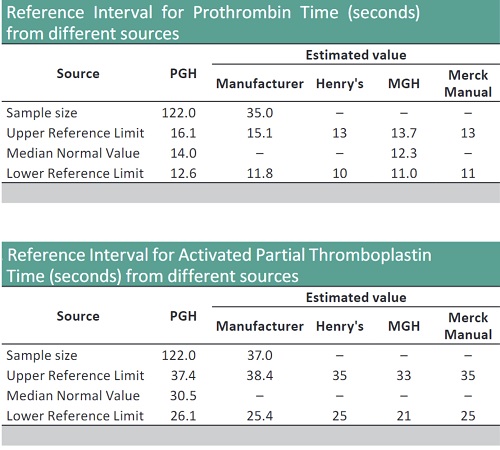Non-parametric Clinical Laboratory Reference Interval Estimation in Volunteer Blood Donors
An Example for Prothrombin Time and Partial Thromboplastin Time
DOI:
https://doi.org/10.21141/PJP.2022.15Keywords:
coagulation, non-parametric reference intervals, Filipino, Prothrombin time, Partial Thromboplastin TimeAbstract
Introduction. To date, there are no reference intervals for prothrombin time (PT) and activated partial thromboplastin time (APTT) based on “normal” Filipino adults. The common practice in most laboratories is to adopt manufacturer provided values or foreign literature even if the importance of establishing or at least verifying laboratory reference intervals has been stressed by Clinical Laboratory Standards Institute (CLSI).
Objectives. Here we aim to describe our experience in using a simple non-parametric method to generate reference intervals for PT and APTT, from healthy Filipino volunteer blood donors.
Methodology. We used a de novo, a priori non-parametric estimation method following the CLSI guidelines on establishing reference intervals.
Results. The non-parametric lower reference limit for PT is 12.55 seconds, with 90% confidence interval of 12.3 to 12.75 seconds. While the non-parametric upper reference limit for PT is 16.15 seconds, with 90% confidence interval of 15.55 to 16.55 seconds. The non-parametric lower reference limit for activated partial thromboplastin time is 26.12 seconds, with 90% confidence interval of 22.95 to 27.1 seconds, and the non-parametric upper reference limit for activated partial thromboplastin time is 37.44 seconds, with 90% confidence interval of 36.75 to 38.65 seconds. The PT and APTT reference intervals were different from foreign sources and manufacturer provided values in terms of interval width and values of the reference limits by 2 to 4 seconds.
Conclusion and Recommendations. Estimation of coagulation reference intervals from volunteer health blood donors is doable, simple, and practical. Collaborative multi-center efforts may be done to expand the pool of reference individuals that are included and increase the representativeness of the reference intervals generated. This simple method can also be used to generate reference intervals for other clinical laboratory assays and may also be extended to at least verify reference intervals in special populations like pregnant women, the elderly, and the pediatric population.
Downloads

Downloads
Published
How to Cite
Issue
Section
License
Copyright (c) 2022 PJP

This work is licensed under a Creative Commons Attribution-NonCommercial-ShareAlike 4.0 International License.

The Philippine Journal of Pathology is licensed under a Creative Commons Attribution-NonCommercial-ShareAlike 4.0 International License. Based on works made open access at http://philippinejournalofpathology.org








